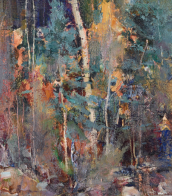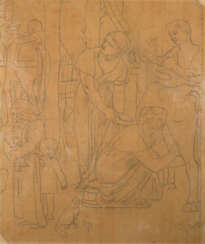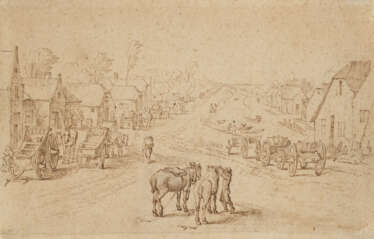building materials


William Jardine was a Scottish naturalist, ornithologist, ichthyologist, artist and publisher of works on zoology.
Jardine studied medicine at the University of Edinburgh and was an excellent sportsman. Although his main passion was ornithology, he also studied ichthyology, botany and geology. Sir William Jardine was a prominent Scottish Victorian naturalist, author and publisher of 40 volumes of the popular Naturalist's Library (1833-43). Of these, 14 volumes were devoted to ornithology, 13 volumes to mammals, 7 volumes to entomology, and 6 volumes to ichthyology.
A series in four volumes, Illustrations on Ornithology, co-written with Prideaux John Selby, was published between 1825 and 1843. His book on burrows and fossil tracks, The Ichnology of Annandale, includes fossils from his ancestral estate. Jardine was a leading expert on salmon and trout in the British Isles. His outstanding knowledge of the species was profound that in 1860 he was appointed a member of the Royal Commission on the Salmon Fisheries of England and Wales. His research culminated in the best and most comprehensive monograph on these fish, "British Salmonids," with the remarkable illustrations by Jardine himself. William Jardine's private natural history museum and library are considered the finest in Britain.


Jean-Antoine Watteau was a French painter and draughtsman whose brief career spurred the revival of interest in colour and movement, as seen in the tradition of Correggio and Rubens. He revitalized the waning Baroque style, shifting it to the less severe, more naturalistic, less formally classical, Rococo. Watteau is credited with inventing the genre of fêtes galantes, scenes of bucolic and idyllic charm, suffused with a theatrical air. Some of his best known subjects were drawn from the world of Italian comedy and ballet.




Henri de Toulouse-Lautrec was a distinguished French Post-Impressionist artist, renowned for his deep insights into Parisian nightlife and the world of entertainment in the 1890s. Born into an aristocratic family in Albi, France, Toulouse-Lautrec faced significant health challenges. He suffered from a rare condition, possibly pycnodysostosis, which stunted the growth of his legs following two fractures during his adolescence, leading to a notably short stature as an adult.
Despite his physical limitations, Toulouse-Lautrec immersed himself in art, becoming a key figure in the Post-Impressionist movement alongside artists like Paul Cézanne and Vincent van Gogh. He is particularly celebrated for his vibrant and expressive depictions of the bohemian lifestyle in late 19th-century Paris, often featuring scenes from brothels and nightlife venues. His unique style combined elements of Art Nouveau and lithography, as evidenced in famous works such as "Moulin Rouge: La Goulue" and "At the Moulin Rouge: The Dance".
Toulouse-Lautrec's work offers a window into the Parisian entertainment scene of his time, marked by a vivid use of color and a candid portrayal of his subjects. His ability to capture the essence of Parisian society, from dancers to prostitutes, in an era of great artistic and cultural dynamism, makes his work particularly valuable to art collectors and experts.
For those interested in the art and life of Henri de Toulouse-Lautrec, staying informed about sales and auction events is essential. Sign up for updates to receive the latest news on pieces by Toulouse-Lautrec available for purchase or auction. This subscription focuses exclusively on new product sales and auction events related to Toulouse-Lautrec, ensuring that enthusiasts and collectors don't miss out on any opportunity to acquire pieces from this iconic artist.


William Eggleston is an American photographer. He is widely credited with increasing recognition for color photography as a legitimate artistic medium. Eggleston's books include William Eggleston's Guide (1976) and The Democratic Forest (1989).


Pierre Cécile Puvis de Chavannes, a prominent French painter, was known as "the painter for France." His influential mural paintings showcased a classicizing style, often referencing visions of Hellenistic Greece.
Puvis received numerous commissions for public and private institutions across France, with significant works in Amiens, Marseille, Lyon, Poitiers, and Paris. His success as a 'painter for France' stemmed from his ability to appeal to various ideologies of the time. In addition to murals, Puvis created easel paintings, some of which can be found in galleries worldwide. Despite his significance, he was not fully appreciated during his lifetime, and his work remains a subject of ongoing art criticism.


John Marin was an American artist, a prominent member of the first generation of American modernists. He is known for his abstract landscapes and watercolors.


Frank Helmut Auerbach is a German-British painter.


Henri de Toulouse-Lautrec was a distinguished French Post-Impressionist artist, renowned for his deep insights into Parisian nightlife and the world of entertainment in the 1890s. Born into an aristocratic family in Albi, France, Toulouse-Lautrec faced significant health challenges. He suffered from a rare condition, possibly pycnodysostosis, which stunted the growth of his legs following two fractures during his adolescence, leading to a notably short stature as an adult.
Despite his physical limitations, Toulouse-Lautrec immersed himself in art, becoming a key figure in the Post-Impressionist movement alongside artists like Paul Cézanne and Vincent van Gogh. He is particularly celebrated for his vibrant and expressive depictions of the bohemian lifestyle in late 19th-century Paris, often featuring scenes from brothels and nightlife venues. His unique style combined elements of Art Nouveau and lithography, as evidenced in famous works such as "Moulin Rouge: La Goulue" and "At the Moulin Rouge: The Dance".
Toulouse-Lautrec's work offers a window into the Parisian entertainment scene of his time, marked by a vivid use of color and a candid portrayal of his subjects. His ability to capture the essence of Parisian society, from dancers to prostitutes, in an era of great artistic and cultural dynamism, makes his work particularly valuable to art collectors and experts.
For those interested in the art and life of Henri de Toulouse-Lautrec, staying informed about sales and auction events is essential. Sign up for updates to receive the latest news on pieces by Toulouse-Lautrec available for purchase or auction. This subscription focuses exclusively on new product sales and auction events related to Toulouse-Lautrec, ensuring that enthusiasts and collectors don't miss out on any opportunity to acquire pieces from this iconic artist.


Paul César Helleu was a French oil painter, pastel artist, drypoint etcher, and designer, best known for his numerous portraits of beautiful society women of the Belle Époque. He also conceived the ceiling mural of night sky constellations for Grand Central Terminal in New York City. He was also the father of Jean Helleu and the grandfather of Jacques Helleu, both artistic directors for Parfums Chanel.


Antoine-François Callet was a French painter of portraits and allegorical works, who acted as official portraitist to Louis XVI.


Joseph Mallord William Turner, a seminal figure in British painting, was born in 1775 and left an indelible mark on the Romantic movement. Known for his expressive coloration, imaginative landscapes, and turbulent marine paintings, Turner's work transcends the traditional boundaries of art to capture the sublime force of nature. His career was distinguished by early talent, evidenced by his acceptance into the Royal Academy at the young age of 14, and a prolific output that included over 2,000 paintings and 19,000 drawings and sketches.
William Turner's unique approach to landscape painting, characterized by dramatic skies and atmospheric effects, set a new standard for capturing mood and emotion on canvas. His innovative use of light and color influenced countless artists, elevating landscape painting to rival the status of history painting. Turner's legacy is also marked by his eccentricity and reclusiveness, traits that only added to the mystique surrounding his artistic genius.
Among his most famous works are "The Fighting Temeraire," symbolizing the passing of the old world, and "Rain, Steam and Speed," capturing the Industrial Revolution's impact. These paintings not only showcase William Turner's technical skill but also his philosophical engagement with the changing world around him.
For collectors and experts in art and antiques, William Turner's works represent the pinnacle of Romantic art, offering insight into the 19th-century aesthetic and philosophical landscape. His influence on subsequent generations of artists underscores his position as a pivotal figure in the history of Western art.
To stay informed about Joseph Mallord William Turner's works and related events, signing up for updates from reputable art institutions can provide valuable insights into new discoveries and auction events related to this master of the British landscape.




Hendrick Avercamp was a seminal Dutch painter during the Dutch Golden Age. He is celebrated as one of the earliest landscape painters of the 17th-century Dutch school, specializing in vibrant winter scenes of the Netherlands. His paintings are filled with colorful and lively depictions of people engaging in various activities against the backdrop of the Dutch winter landscape.
Educated by the Danish-born portrait painter Pieter Isaacsz, Hendrick Avercamp's work reflects a strong influence from the Flemish painting tradition, especially evident in the landscapes reminiscent of Pieter Bruegel the Elder. His technique of aerial perspective, where objects in the foreground are painted with richer colors than those in the distance, creates a remarkable impression of depth in his paintings.
Hendrick Avercamp's most ambitious and acclaimed work, 'Winter Landscape with Ice Skaters', painted around 1608, is a detailed panorama of human and animal activities during a harsh winter. This painting, along with others like 'Winter Landscape with a Frozen River and Figures' and 'Winter Landscape with Skates and People Playing Golf', showcase his knack for narrative, capturing various facets of 17th-century Dutch society enjoying the winter season.
Despite being mute and probably deaf, Hendrick Avercamp's keen observation skills are evident in his works, where he intricately portrays diverse classes engaging in various winter activities. He produced about a hundred paintings, many of which can be seen in the Rijksmuseum in Amsterdam and the Mauritshuis in The Hague. His work was also celebrated for its historical quality, providing a glimpse into the life of different societal levels in the Netherlands at that time.
For collectors and enthusiasts of art and antiques, Hendrick Avercamp's paintings offer a fascinating window into the Dutch Golden Age, with their vivid portrayal of life and activities in a winter setting. His works, characterized by meticulous detail and a cheerful narrative, remain an integral part of the conversation in the history of Dutch art.
To stay updated on the latest insights and collections related to Hendrick Avercamp's works, consider subscribing to our updates. Stay informed about new sales, exhibitions, and auction events featuring this master of Dutch winter landscapes.




Paul Cézanne, a French Post-Impressionist painter, was pivotal in shaping the transition from 19th-century art to a new, revolutionary approach in the 20th century. His unique and exploratory brushstrokes, utilizing planes of color to form complex fields, made his work instantly recognizable and influential in the development of Cubism.
Cézanne’s early works, influenced by Romanticism and Realism, evolved into a groundbreaking artistic language. He challenged traditional perspective and academic art rules, focusing on objects' structural aspects and art's formal qualities. This approach led to a renewed emphasis on impressionistic color space and modulation principles.
His most notable works, like “Mont Sainte-Victoire,” “The Card Players,” and “The Bathers,” display his mastery in creating depth and dimension through color gradations. These paintings, initially met with skepticism, eventually cemented Cézanne’s reputation as a pioneering artist. His exhibitions, particularly the one-man show by dealer Ambroise Vollard in 1895, played a critical role in his recognition.
Cézanne’s impact on art history is profound, with greats like Henri Matisse and Pablo Picasso acknowledging him as a significant influence. His exploration of geometric forms and innovative use of light and color laid the groundwork for subsequent movements, particularly Cubism.
For collectors and art experts, Cézanne's works are more than just paintings; they are pivotal chapters in the narrative of modern art. His creations, bridging Impressionism and Cubism, continue to inspire and challenge contemporary artists.
To stay updated on new product sales and auction events related to Paul Cézanne, sign up for our updates. This subscription ensures you remain informed about the latest developments in the world of this revolutionary artist.




Jan Brueghel the Elder, a Flemish painter born in 1568 in Brussels, was a pivotal figure in the Baroque period known for his intricate landscapes, detailed still lifes, and genre scenes. The son of Pieter Bruegel the Elder, Jan was distinguished by his delicate brushwork, earning him the nicknames "Velvet" Brueghel, "Flower" Brueghel, and "Paradise" Brueghel, each reflecting a different aspect of his versatile artistic output. His monikers refer to his skill in rendering fabrics, his specialization in flower still lifes, and his creation of the paradise landscape genre, respectively.
After early training in Brussels, possibly under the guidance of his grandmother Mayken Verhulst, and further studies in Antwerp, Brueghel ventured to Italy, where he worked in Rome under the patronage of Cardinal Ascanio Colonna and met influential artists like Paul Bril. His Italian sojourn greatly influenced his style, especially in landscape painting. Upon returning to Antwerp, he established a flourishing workshop and became a master in the Guild of St. Luke. Brueghel's collaborations with Peter Paul Rubens are among the most celebrated in art history, showcasing a harmonious blend of landscape and figure painting.
Jan Brueghel the Elder's works are prized for their vibrant depiction of nature and meticulous attention to detail. His landscapes are not just backdrops but are lively settings filled with rich narratives and a variety of creatures, reflecting his deep appreciation for the natural world. His flower pieces are equally renowned for their variety and realism, often serving as allegorical or symbolic representations.
Brueghel's legacy extends beyond his paintings; he was a pivotal figure in the Antwerp artistic community, serving as dean of the Guild of St. Luke and court painter to the Archduke Albert of Austria and the Infanta Isabella Clara Eugenia of Spain. His influence continued through his children, with his son Jan Brueghel the Younger continuing his workshop and maintaining the family's artistic traditions.
For collectors and experts in art and antiques, Jan Brueghel the Elder's works represent a high point in Flemish Baroque art, offering a glimpse into the era's aesthetic values and the artist's profound observation of the world around him. His paintings, found in museums and galleries worldwide, continue to captivate audiences with their beauty and depth.
To stay informed about new discoveries, sales, and auction events related to Jan Brueghel the Elder's work, consider signing up for updates. This subscription will ensure that you are always in the know about opportunities to engage with the enduring art of this Flemish master.


Frank Lloyd Wright was an American architect, interior designer, writer, and educator. He is widely regarded as one of the most important and innovative architects of the 20th century, with a career spanning over 70 years.
Wright is known for his organic architecture philosophy, which aimed to create structures that were in harmony with their natural surroundings. He designed over 1,000 structures, including private homes, public buildings, and commercial buildings, such as the iconic Guggenheim Museum in New York City.
Some of Wright's most famous works include Fallingwater, a private residence built over a waterfall in Pennsylvania, and the Robie House, a Prairie-style home in Chicago. He also designed the Imperial Hotel in Tokyo, which survived the Great Kanto Earthquake of 1923.
Throughout his career, Wright was known for his innovative use of materials, such as his signature use of concrete blocks, and for his emphasis on the relationship between the built environment and the natural world. He also wrote extensively on architecture and design, publishing over 20 books and numerous articles throughout his life.
Frank Lloyd Wright's influence on modern architecture is profound, and his work continues to be studied and celebrated around the world. He is often regarded as a pioneer of modern architecture and a master of American design.


Frank Lloyd Wright was an American architect, interior designer, writer, and educator. He is widely regarded as one of the most important and innovative architects of the 20th century, with a career spanning over 70 years.
Wright is known for his organic architecture philosophy, which aimed to create structures that were in harmony with their natural surroundings. He designed over 1,000 structures, including private homes, public buildings, and commercial buildings, such as the iconic Guggenheim Museum in New York City.
Some of Wright's most famous works include Fallingwater, a private residence built over a waterfall in Pennsylvania, and the Robie House, a Prairie-style home in Chicago. He also designed the Imperial Hotel in Tokyo, which survived the Great Kanto Earthquake of 1923.
Throughout his career, Wright was known for his innovative use of materials, such as his signature use of concrete blocks, and for his emphasis on the relationship between the built environment and the natural world. He also wrote extensively on architecture and design, publishing over 20 books and numerous articles throughout his life.
Frank Lloyd Wright's influence on modern architecture is profound, and his work continues to be studied and celebrated around the world. He is often regarded as a pioneer of modern architecture and a master of American design.



































































